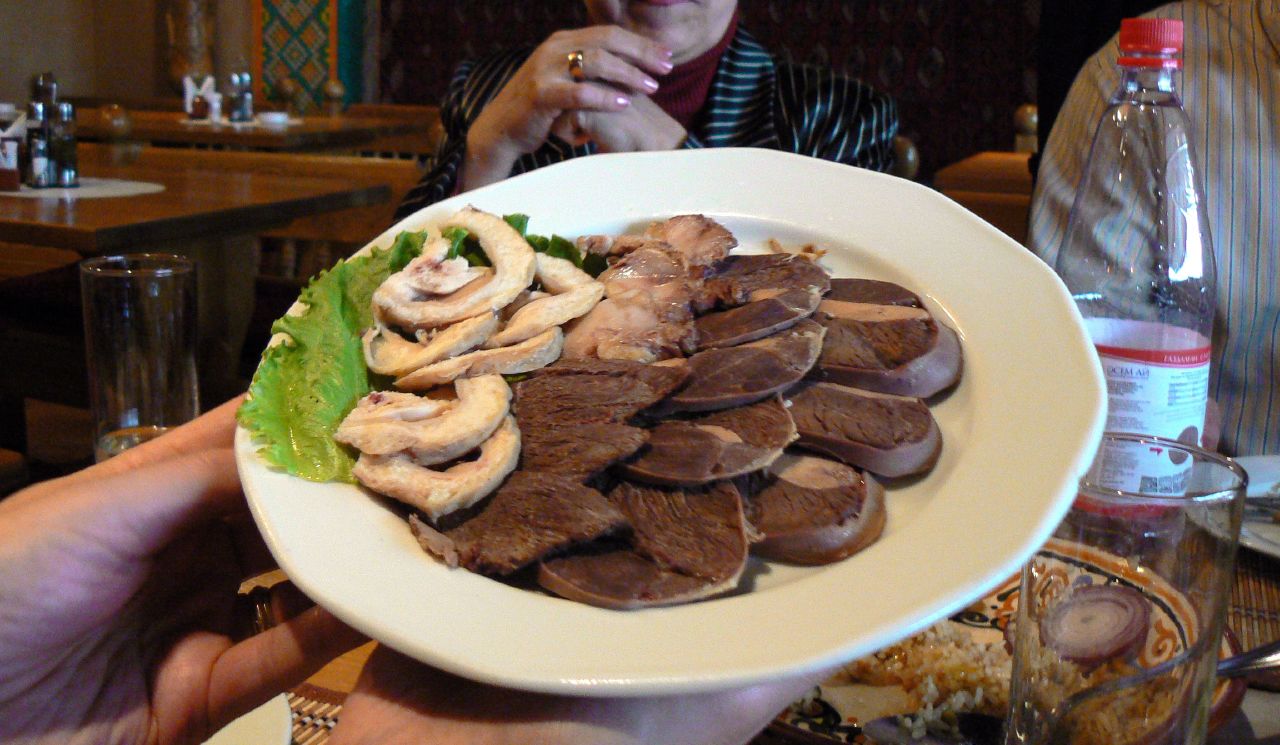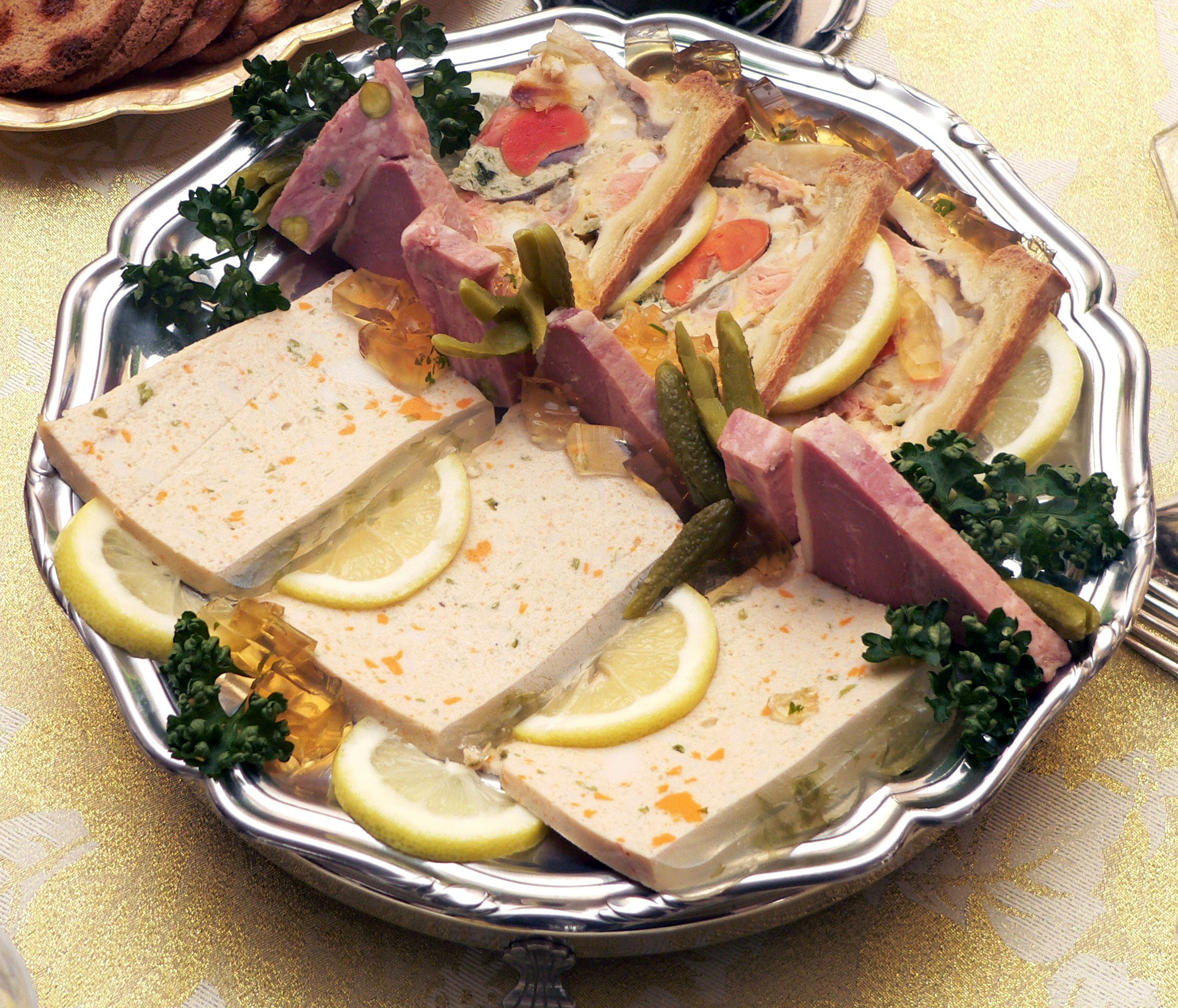|
Kazakh Cuisine
Traditional Kazakh cuisine is the traditional food of the Kazakh people. It is focused on mutton and horse meat, as well as various Dairy products, milk products. For hundreds of years, Kazakhs were herders who raised fat-tailed sheep, Bactrian camels, and horses, relying on these animals for transportation, clothing, and food. The cooking techniques and major ingredients have been strongly influenced by the nation's nomadic way of life. For example, most cooking techniques are aimed at long-term Food preservation, preservation of food. There is a large practice of salting and drying meat so that it will last, and there is a preference for sour milk, as it is easier to save in a nomadic lifestyle. Meat in various forms has always been the primary ingredient of Kazakh cuisine, and traditional Kazakh cooking is based on boiling. Horse and mutton are the most popular forms of meat and are most often served in large uncut pieces which have been boiled. Kazakhs cared especially for hor ... [...More Info...] [...Related Items...] OR: [Wikipedia] [Google] [Baidu] |
Mutton
Lamb and mutton, collectively sheep meat (or sheepmeat) is one of the most common meats around the world, taken from the domestic sheep, ''Ovis aries'', and generally divided into lamb, from sheep in their first year, hogget, from sheep in their second, and mutton, from older sheep. Generally, "hogget" and "sheep meat" aren't used by consumers outside Norway, New Zealand, South Africa, Scotland, and Australia. Hogget has become more common in England, particularly in the North (Lancashire and Yorkshire) often in association with rare breed and organic farming. In South Asian and Caribbean cuisine, "mutton" often means goat meat.''Oxford English Dictionary'', 3rd edition, June 2003Italian, make similar or even more detailed distinctions among sheep meats by age and sometimes by sex and diet—for example, ''lechazo'' in Spanish refers to meat from milk-fed (unweaned) lambs. Classifications and nomenclature The definitions for lamb, hogget and mutton vary considerably between ... [...More Info...] [...Related Items...] OR: [Wikipedia] [Google] [Baidu] |
Beef
Beef is the culinary name for meat from cattle (''Bos taurus''). Beef can be prepared in various ways; Cut of beef, cuts are often used for steak, which can be cooked to varying degrees of doneness, while trimmings are often Ground beef, ground or minced, as found in most hamburgers. Beef contains protein, iron, and vitamin B12. Along with other kinds of red meat, high consumption is associated with an increased risk of colorectal cancer and coronary heart disease, especially when processed meat, processed. Beef has a high Environmental impact of meat production, environmental impact, being a primary driver of deforestation with the highest greenhouse gas emissions of any agricultural product. In prehistoric times, humans hunted aurochs and later domesticated them. Since that time, numerous beef cattle, breeds of cattle have been Selective breeding, bred specifically for the quality or quantity of their meat. Today, beef is the third most widely consumed meat in the world, aft ... [...More Info...] [...Related Items...] OR: [Wikipedia] [Google] [Baidu] |
Onions
An onion (''Allium cepa'' , from Latin ), also known as the bulb onion or common onion, is a vegetable that is the most widely cultivated species of the genus ''Allium''. The shallot is a botanical variety of the onion which was classified as a separate species until 2011. The onion's close relatives include garlic, scallion, leek, and chives. The genus contains several other species variously called onions and cultivated for food, such as the Japanese bunching onion '' Allium fistulosum'', the tree onion ''Allium'' × ''proliferum'', and the Canada onion '' Allium canadense''. The name '' wild onion'' is applied to a number of ''Allium'' species, but ''A. cepa'' is exclusively known from cultivation. Its ancestral wild original form is not known, although escapes from cultivation have become established in some regions. The onion is most frequently a biennial or a perennial plant, but is usually treated as an annual and harvested in its first growing season. The ... [...More Info...] [...Related Items...] OR: [Wikipedia] [Google] [Baidu] |
Offal
Offal (), also called variety meats, pluck or organ meats, is the internal organ (anatomy), organs of a butchered animal. Offal may also refer to the by-products of Milling (grinding), milled grains, such as corn or wheat. Some cultures strongly consider offal consumption to be taboo, while others use it as part of their everyday food, such as lunch meats, or, in many instances, as Delicacy, delicacies. Certain offal dishes—including ''foie gras'' and ''pâté''—are often regarded as gourmet food in the culinary arts. Others remain part of traditional regional cuisine and are consumed especially during holidays; some examples are sweetbread, Jewish chopped liver, Scottish haggis, U.S. chitterlings, and Mexican Menudo (soup), menudo. On the other hand, intestines are traditionally used as casing for sausages. Depending on the context, ''offal'' may refer only to those parts of an animal carcass discarded after butchering or skinning; offal not used directly for human or anim ... [...More Info...] [...Related Items...] OR: [Wikipedia] [Google] [Baidu] |
Sheep
Sheep (: sheep) or domestic sheep (''Ovis aries'') are a domesticated, ruminant mammal typically kept as livestock. Although the term ''sheep'' can apply to other species in the genus '' Ovis'', in everyday usage it almost always refers to domesticated sheep. Like all ruminants, sheep are members of the order Artiodactyla, the even-toed ungulates. Numbering a little over one billion, domestic sheep are also the most numerous species of sheep. An adult female is referred to as a ''ewe'' ( ), an intact male as a ''ram'', occasionally a ''tup'', a castrated male as a ''wether'', and a young sheep as a ''lamb''. Sheep are most likely descended from the wild mouflon of Europe and Asia, with Iran being a geographic envelope of the domestication center. One of the earliest animals to be domesticated for agricultural purposes, sheep are raised for fleeces, meat ( lamb, hogget or mutton), and milk. A sheep's wool is the most widely used animal fiber, and is usually harvested by ... [...More Info...] [...Related Items...] OR: [Wikipedia] [Google] [Baidu] |
Kuyrdak
Kuurdak (, Quyrdaq, , ; Говурдак, , , ), transliterated with various spellings, is a traditional meat dish made in Central Asia. The name comes from a nominalization of the word "roast", "fried", referring to how the food is made. It is described as "stewed brown meat". Kuurdak is known in Turkish cuisine as kavurma usually made from lamb, mutton, beef, or sheep liver, or sometimes with vegetables. See also * List of lamb dishes This is a list of the popular lamb and mutton dishes and foods worldwide. Lamb and mutton are terms for the meat of domestic sheep (species ''Ovis aries'') at different ages. A sheep in its first year is called a lamb, and its meat is also called ... * References Kazakh cuisine Soviet cuisine Kyrgyz cuisine Uzbekistani cuisine Lamb dishes National dishes Turkmen cuisine Mongolian cuisine {{CAsia-stub ... [...More Info...] [...Related Items...] OR: [Wikipedia] [Google] [Baidu] |
Shuzhuk
Sujuk or sucuk ( /suːˈd͡ʒʊk/) is a dry, spicy and fermented sausage which is consumed in several Turkish, Balkan, Middle Eastern and Central Asian cuisines. Sujuk mainly consists of ground meat and animal fat usually obtained from beef or lamb, but beef is mainly used in Turkey, Bosnia and Herzegovina, Albania, Armenia, Georgia, Bulgaria, Kazakhstan, and Kyrgyzstan. Etymology and terminology ''Sucuk'' was first mentioned in the 11th century by Mahmud al-Kashgari in his ''Dīwān Lughāt al-Turk'' as ''suɣut''. Another mention was made by Abu Hayyan al-Gharnati in his early 14th century work titled ''Kitab al-'idrak li-lisan al-'atrak'' (). The word "suɣut" itself means "sujuk, or dried thing" and derived from Turkic root -suɣur meaning to dry or to drain off and the suffix "-çïk/-çuk" is Turkic diminutive suffix (Suɣutçuk => Sucuk). But according to some sources, this word evolved from a Middle Iranian word attested in Early New Persian as ''zīç'' () and ''ziwīdj' ... [...More Info...] [...Related Items...] OR: [Wikipedia] [Google] [Baidu] |
Qarta
Qarta is a Kazakh, Kyrgyz and Uzbek dish of boiled and pan-fried horse rectum, taken from the final few inches of digestive tract before the muscular part of the anus. It is served without sauce or spices."I ate horse ass in Kazakhstan" Vice. The section includes "strong tissue on the outside" and "gradations of tender mucous membrane tissue and fatty mass on the inside" and includes a layering of soft and hard tissues that dense and varied with fat, according to a reviewer from . It is prepared in various ways to clean it thoroughly and remove any unpleasant taste due to the provenance of the tissue. One method is to turn it inside out and wash it thoroughly. It can also be |
Qazı
Qazı (, ''qazı'', قازى ; ; , ''Kazy-karta''; , , ) is a traditional sausage-like food of Bashkirs, Kazakhs, Tatars, Kyrgyz, Uzbeks and other Turkic or Central Asian ethnic groups.I ate horse ass in Kazakhstan Vice It is a common element on a dastarkhan, a table set for a festive meal. A reviewer from described the dish as smoky and earthy. is usually used for Qazı. Preparation The horse's ribs are removed, ...[...More Info...] [...Related Items...] OR: [Wikipedia] [Google] [Baidu] |
Kuurdak
Kuurdak (, Quyrdaq, , ; Говурдак, , , ), transliterated with various spellings, is a traditional meat dish made in Central Asia. The name comes from a nominalization of the word "roast", "fried", referring to how the food is made. It is described as "stewed brown meat". Kuurdak is known in Turkish cuisine as kavurma usually made from lamb, mutton, beef, or sheep liver, or sometimes with vegetables. See also * List of lamb dishes This is a list of the popular lamb and mutton dishes and foods worldwide. Lamb and mutton are terms for the meat of domestic sheep (species ''Ovis aries'') at different ages. A sheep in its first year is called a lamb, and its meat is also called ... * References Kazakh cuisine Soviet cuisine Kyrgyz cuisine Uzbekistani cuisine Lamb dishes National dishes Turkmen cuisine Mongolian cuisine {{CAsia-stub ... [...More Info...] [...Related Items...] OR: [Wikipedia] [Google] [Baidu] |
Sorpa
Chorba ( ; ) or shorba ( ; ) is a broad class of stews or rich soups found in national cuisines across the Middle East, Algeria, Maghreb, Iran, Turkey, Southeast Europe, Central Asia, East Africa and South Asia. It is often prepared with added ingredients but is also served alone as a broth or with bread. Etymology The word ''chorba'' in English and in many Balkan languages is a loan from the Ottoman Turkish , which itself is a loan from Persian . The spelling ''shorba'' could be a direct loan into English from Persian or through a Central or South Asian intermediary. The word is ultimately a compound of meaning 'salty, brackish' and meaning 'stew, gruel, spoon-meat'. The former is from Parthian meaning 'salty', and the latter from Middle Persian meaning 'gruel, spoon-meat'. The etymology can be definitively tied to Persian through the cognate ; in modern Persian, while evolved to mean 'broth, stew', simply means 'soup'. It is typical for Middle Persian word-final ... [...More Info...] [...Related Items...] OR: [Wikipedia] [Google] [Baidu] |




